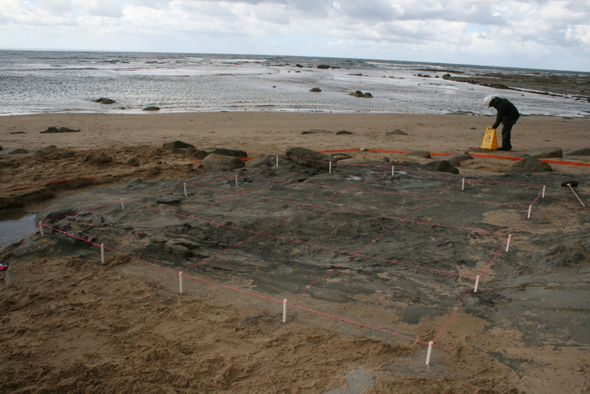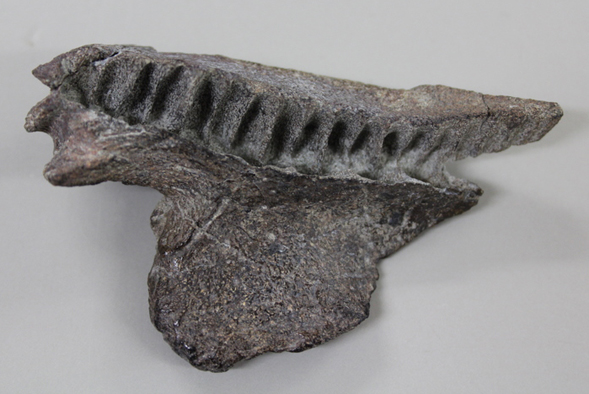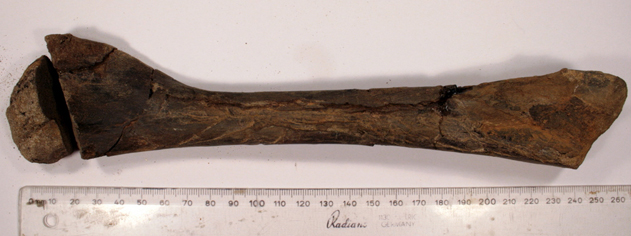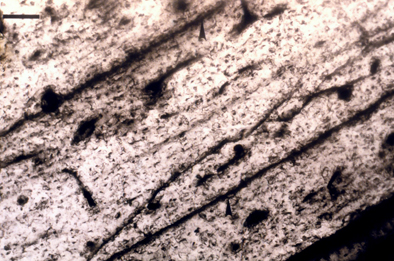| Monash home | About Monash | Faculties | Campuses | Contact Monash |
| Staff directory | A-Z index | Site map |
| Monash home | About Monash | Faculties | Campuses | Contact Monash |
| Staff directory | A-Z index | Site map |
|
Dinosaur Dreaming website update 3 October 20112011 marks the 20th anniversary of the discovery of the Flat Rocks site, near Inverloch and the 18th Dinosaur Dreaming field season. It is hard to believe that 20 years have elapsed since a group of researchers discovered a four metre wide conglomerate layer exposed on the rocky shore platform, just south of Inverloch, Victoria. The discovery caused great excitement as it was the first time that a number of bones had been found, along the Victorian south coast, so close together in one fossil layer. Twenty bones were discovered exposed on the surface of the fossil layer, but they proved to be just the “tip of the iceberg”. A test dig, which took place in 1992 to explore the potential of the site, resulted in the recovery of over 300 fossil bones and teeth and so the Dinosaur Dreaming site was born. In the past 20 years many thousands of bones and teeth have been recovered from the Flat Rocks site, making it the richest Early Cretaceous site in Australia. Although it has not produced articulated skeletons, like those from Dinosaur Cove and Eric the Red in the Otway Group, it is the only site in Australia where evidence of three groups of mammals has been found, alongside the bones of at least six different types of dinosaurs. The Dinosaur Dreaming 2011 field season differed in a number of ways from the previous 17 field seasons: The field season was shortened to three weeks duration to allow for two additional digs at the Eric the Red site in the Otway Group, the Dinosaur Dreaming team had a new “dig house” as the original dig house, which had accommodated the team since 1994, was unavailable and a new site was explored just north of the Flat Rocks site. In August 2010 the sand along the shore platform near The Caves area was very low and a patch of conglomerate rock was exposed 200 m north of the Flat Rocks site. This conglomerate layer covers an area of approximately 36 square metres, roughly 6m by 6m. A number of bones have been recovered from this layer in the past when it is periodically exposed. A chance visit to the area in August revealed four bones exposed in the layer and as it was a defined area it was decided that a small test excavation should take place during the 2011 field season. The layer was given the name “Swim O’clock Rock” as it was situated close to the team’s swimming hole.  Swim O'clock Rock site This site was sampled during the Dinosaur Dreaming 2011 field season and although it yielded 25 bones, it was decided that no future excavations were necessary. The fossilised bones were mainly fish and turtles, commonly found in the many fluvial deposits along the Bass Coast. A partial tooth and two toe bones were evidence of small ornithopod dinosaurs. Excavations at the Flat Rocks site also continued, with emphasis on the most easterly end of the site, closest to the sea. A shorter field season resulted in the discovery of fewer than normal fossils, but some well preserved specimens were found including a number of dinosaur limb bones and a complete turtle skull. A bone that was found by Mike Cleeland north of the Flat Rocks site a number of years ago was finally prepared by preparators at Museum Victoria in Melbourne. The bone turned out to be from the skull of a large amphibian, possibly Koolasuchus cleelandi, and caused quite a stir. Until this bone was prepared it was thought that the large amphibians were limited to the western outcrops of the Early Cretaceous Strzelecki Ranges, around San Remo. The discovery of this skull fragment north of the Flat Rocks site and close to Inverloch means that these animals were not as geographically restricted as was previously thought.  Temnospondyl maxilla. Meanwhile, exciting research was being carried out in the Vertebrate Palaeontology laboratory at Museum Victoria: Dinosaur tracks were discovered at two localities along the Otway Coast, southwest of Melbourne. The tracks were found in large boulders at both sites and were subsequently removed and transported back to the Melbourne Museum. Preliminary examination by renowned fossil trackways expert, Anthony Martin, has revealed that most of the tracks were made by small theropod dinosaurs. A number of overseas researchers visited the Museum in the last 12 months, including Fernando Novas from Buenos Aires, Argentina and Roger Benson from London, UK, who spent some time reviewing the theropod dinosaur material in the Collection. Roger also participated in the Otway dig in March this year, as well as visiting the fossil localities along the Bass Coast. He was able to identify a number of theropod bones in the Museum Collection that had previously been unidentified, resulting in an increase in the number of theropod species from the Early Cretaceous of Victoria.  Ornithopod tibia found by Roger Benson and Mike Cleeland at Eagle’s Nest. Holly Woodward from Montana, USA worked with Museum Collections Manager David Pickering to make thin sections of some of the dinosaur leg bones. Microscopic evidence of dense rings in the bone, called “Lines of Arrested Growth” indicated that the metabolic rate in adult dinosaurs slowed down at some point each year. This is similar to growth rings in trees. Microscopic examination of juvenile dinosaur bones indicated a rapid growth rate up to three years of age.  Dinosaur bone showing Lines of Arrested Growth Paul Barrett from the Natural History Museum, London published a paper on a fragment of neck vertebra of a spinosaur, the first fossil of that group reported from Australia. The vertebra came from the same site in the Otway Group where a partial ornithopod dinosaur skeleton was found in 2005. Preparation is continuing on the first partial dinosaur skeleton found in the Strzelecki Group. It has been nicknamed “Noddy” as it was found in a nodule on the shore platform, not far from the seaside town of Inverloch. The skeletal remains include most of the skull, articulated neck and thorax vertebrae, scapula and coracoid and most of the ribs. Work is painstakingly slow as the matrix is very hard. Work also continues on a partial Koolasuchus cleelandi skull, found by Andrew Ruffin near San Remo. One side of the skull is preserved and it is hoped to create a mirror image of the other side when preparation is finished, resulting in an almost complete skull. Tom Rich, head researcher of the Dinosaur Dreaming project, spent some time overseas this year in an effort to discover the identity of a tiny fragment of mammal maxilla (upper jaw), found by Alanna Maguire at the Eric the Red site in the Otway Group, southwest of Melbourne. The fragment, along with 22 other Victorian Cretaceous mammal jaws, was scanned at the Spring 8 Synchrotron in Honshu, Japan. The scans are instrumental in the reconstruction of the tiny jaw fragment and it is hoped that eventually the researchers will be able to fit it into the mammalian evolutionary tree. Preparations are well under way for Dinosaur Dreaming 2012. Applications for places on the Dinosaur Dreaming team have been received and will be processed in the next month or so. The dates for Dinosaur Dreaming 2012 at Inverloch, Victoria are from 11th February to 2nd March inclusive. We will be continuing excavations at the Flat Rocks site and looking forward to what new treasures we will uncover. |